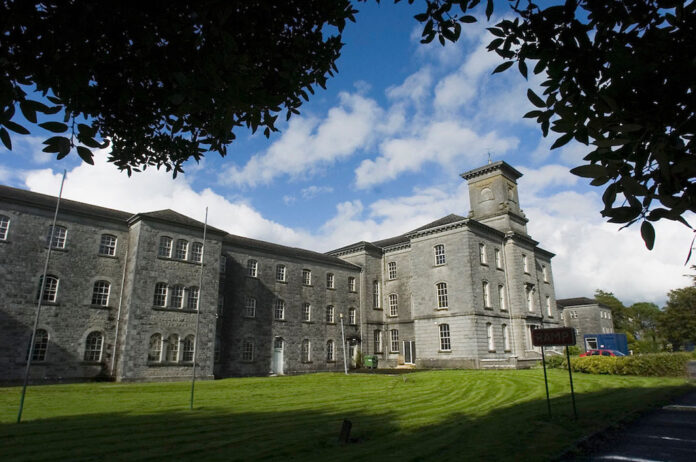ENNIS Mental Hospital, the now closed Our Lady’s Hospital, features prominently in a new history of psychiatry in Ireland.
Brendan Kelly, consultant psychiatrist and professor of psychiatry in Trinity College, Dublin, in his new book, Hearing Voices: The History of Psychiatry in Ireland (Irish Academic Press), gives an insight into what life was like in “public asylums” in the 19th and early 20th centuries.
In Ireland, the history of psychiatry is dominated by the vast network of public asylums that opened across the country during the 1800s. This extraordinary mass institutionalisation was underpinned by genuine concern for the destitute mentally ill, who lived lives of vagrancy or languished in prisons in the early 1800s. Despite the initial idealism, however, the asylums were soon overcrowded, anti-therapeutic and extremely unhealthy places.

Professor Barry Kelly
This large gap between rhetoric and reality was demonstrated vividly in 1843, when a select committee of the House of Lords provided a hard-hitting report on the “state of the lunatic poor in Ireland”.
“It has been unfortunately found that, although the accommodation provided in the 10 district asylums very considerably exceeds that which was contemplated by the committee of 1817, it is very far from meeting the necessity of the case. The asylums were originally intended but for 1,220 patients; they now contain 2,028; various additions have been made to them [providing] for the reception of 264 patients; but the increased and rapidly increasing number of incurable cases have lamentably diminished the efficacy of these asylums as hospitals for the cure of insanity,” the report read.
The 1843 committee concluded that the mentally ill should no longer be kept in unsuitable locations, such as prisons. They articulated “the necessity of increasing the accommodation for pauper lunatics in Ireland, and of providing for the cases of epilepsy, idiocy and chronic disease, by an increased number of the district Asylums, by an enlargement of those asylums, or by the erection of separate establishments specially appropriated for these classes of patients”.
As the Lunatic Asylums, Ireland, Commission emphasised in 1858, “It is of the utmost importance that cases of insanity should as speedily as possible be removed to an asylum.” Throughout the 1800s and early 1900s, asylums were invariably seen as the answer to the problems presented by the mentally ill. Ennis is a good example.
The Ennis Asylum (1868): “Dances are held weekly”
Ireland’s programme of asylum-building was an extensive one, eventually involving a range of individual architects and including the asylum in Ennis (with its Florentine palazzo, in 1868), the Monaghan asylum (the first to adopt a villa or pavilion format, in 1869) and the auxiliary asylum to the Richmond Asylum (Grangegorman, Dublin), in Portrane, County Dublin (1900).
By that time, approximately 21,000 people, or 0.5% of the population of the 32 counties of Ireland, were accommodated in the district asylums, with a small number of the mentally ill still in workhouses.
In 1906, there were 409 patients in the Ennis Mental Hospital, which also had a medical superintendent and just one assistant medical officer.
Overcrowding was a persistent problem in Ennis, as was the case elsewhere. This led to the inevitable expansion of many asylums, including Ennis. In 1931, the Inspector of Mental Hospitals reported in some detail on the situation in Ennis, with a mix of positive and negative observations.
“The new buildings, which will soon be completed, will relieve the very much overcrowded state of the institution [in Ennis]. Open-air shelters or verandas should be erected for tubercular cases. Restraint and seclusion were necessary in a few cases.
“The practice of allowing patients to be absent on trial should be extended. Notwithstanding the overcrowding, the institution is maintained in a satisfactory manner. Sanitary and bathing accommodation require to be improved. A number of patients are employed on the farm, but only a few are engaged with the tradesmen. The feasibility of the employment of a larger proportion of the patients should be considered.
“The female patients are employed in the laundry and kitchens and at knitting, sewing, rug-making and repair work. Dances are held weekly, and gramophones, cards and draughts are supplied. Chemical extinguishers, fire hydrants and hose are provided. The water pressure is good. Twenty-two attendants and 26 nurses are undergoing instruction with a view to obtaining the nursing certificate. The dietary is ample and satisfactory.”
The hospital in Ennis, then, demonstrated many of the key features of many of the asylums in early 20th-century Ireland: large numbers of patients, extensive efforts to provide activities and amusements, and the increased professionalisation of clinical staff, though training.
Even so, it remains the case that the Irish mental hospitals were simply too large and too institutional in their processes and procedures. While real efforts were made to treat and support patients, and mental hospitals were often quite integrated with local communities, they were, nonetheless, still big institutions, with all of the problems that big institutions invariably bring: chronic overcrowding, problems keeping large numbers of patients and staff safe and well, and a shift in focus from individual patient care to managing the large, unwieldy establishments themselves.
An epidemic of mental hospitals, not an epidemic of mental illness
It is now clear that Ireland in the 1800s and early 1900s suffered from an epidemic of mental hospitals and not an epidemic of mental illness. The hospitals were underpinned by unmet social need, unhelpful legislation and a desire by communities to find places for the mentally ill, intellectually disabled and people who did not fit in. Families often had very limited resources to care for such persons at home; the only solution offered by the state was an institutional one; and the objections of asylum doctors fell on deaf ears. The asylums were essentially unstoppable.
In the mid-1900s, the psychiatric system was finally reformed with the belated arrival of the Mental Treatment Act 1945, the 1966 Commission of Inquiry on Mental Illness and the advent of new treatments in the 1950s and 1960s (for example, anti-psychotic medication). These developments were supported by broader changes across Irish society at this time, with diminished tolerance for all kinds of institutions in Irish life.
The shadow of the asylum has, however, never disappeared fully. And the best way to remember the mentally ill who crowded into them in the past, is to ensure good mental health and social services for the mentally ill today. There is still much to do.
A native of Ennis, Colin McGann has been editor of The Clare Champion since August 2020. Former editor of The Clare People, he is a journalism and communications graduate of Dublin Institute of Technology.


